Hotpoint AQ113DA 697 EU-B Operating Instructions

Instructions for installation and use
WASHING MACHINE
EN GR TR
English,1 |
ΕΛΛΗΝΙΚΑ, 13 Türkçe,25 |
Contents |
EN |
|
Installation, 2-3
Unpacking and levelling
Connecting the electricity and water supplies
Technical data
PL
Polski,37
Care and maintenance, 4
Cutting off the water and electricity supplies Cleaning the machine
Cleaning the detergent dispenser drawer Caring for your appliance drum Cleaning the pump
Checking the water inlet hose
AQUALTIS
AQ113DA 697
Precautions and tips, 5
General safety
Load balancing system Disposal
Opening the porthole door manually
Description of the machine, 6-7
Touch control panel
Running a wash cycle, 8
Wash cycles and options, 9
Table of wash cycles Wash options
Detergents and laundry, 10
Detergent
Preparing the laundry Washing recommendations
Trouble shooting, 11
Assistance, 12
1
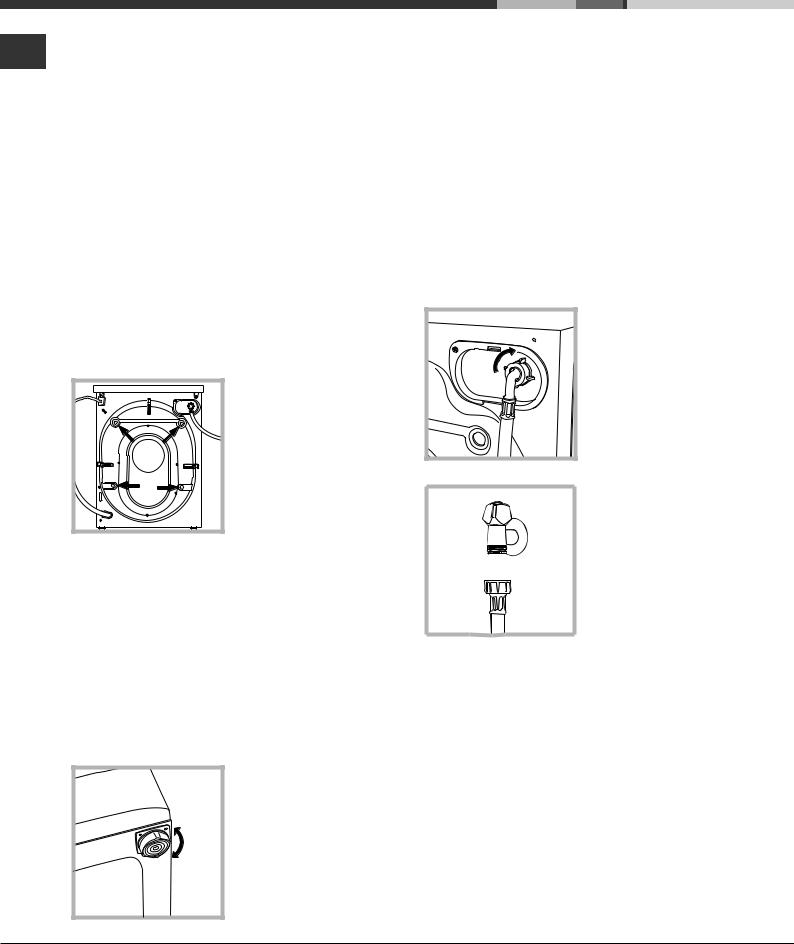
Installation
EN |
! This instruction manual should be kept in a |
|
safe place for future reference. If the washing |
||
|
||
|
machine is sold, given away or moved, please |
|
|
ensure the manual is kept with the machine, |
|
|
so that the new owner may benefit from the |
|
|
advice contained within it. |
|
|
! Read these instructions carefully: they |
|
|
contain vital information relating to the safe |
|
|
installation and operation of the appliance. |
|
|
! Inside the pack containing this manual, you |
|
|
will also find the guarantee and all the details |
|
|
necessary for installation. |
|
|
Unpacking and levelling |
|
|
Unpacking |
|
|
1. Once you have removed all the packaging |
|
|
from the washing machine, make sure it has not |
|
|
been damaged during transportation. If it has |
|
|
been damaged, contact the retailer and do not |
|
|
proceed any further with the installation process. |
|
|
2. Remove the 4 |
|
|
protective screws |
|
|
(used during |
|
|
transportation) and |
|
|
the corresponding |
|
|
spacer, located on |
|
|
the rear part of the |
|
|
appliance (see figure). |
3.Close off the holes using the plastic plugs supplied in the pack.
4.Keep all the parts in a safe place; they will be needed again if the washing machine is moved to another location, to prevent the inside of the appliance being damaged.
! Packaging materials should not be used as toys for children.
Levelling
1. Place the washing machine on a flat sturdy floor, without resting it up against walls or cabinets.
2. If the floor is uneven, the front feet of the machine may be adjusted until it reaches a horizontal position (the angle of inclination must not exceed 2 degrees).
!If the appliance is levelled correctly, it will be more stable and much less likely to cause vibrations and noise while it is operating, particularly during the spin cycle.
!If it is placed on carpet or a rug, adjust the feet in such a way as to allow a sufficient ventilation space underneath the washing machine.
Connecting the electricity and water supplies
Connecting the water inlet hose
! Before connecting the inlet hose to the water supply, run the water until it is perfectly clear.
1. Connect the inlet hose to the machine by screwing it onto the cold water inlet of the appliance, which is situated on the top right-hand side of the rear part of the appliance (see figure).
2. Connect the inlet hose by screwing it to a cold water tap using a 3/4 gas threaded connection (see figure).
3. Make sure that the hose is not folded over or bent.
! The water pressure at the tap must fall within the values indicated in the Technical data table
(see next page).
!If the inlet hose is not long enough, contact a specialised shop or an authorised technician.
!Never use second-hand or old inlet hoses; use the products supplied with the machine.
2
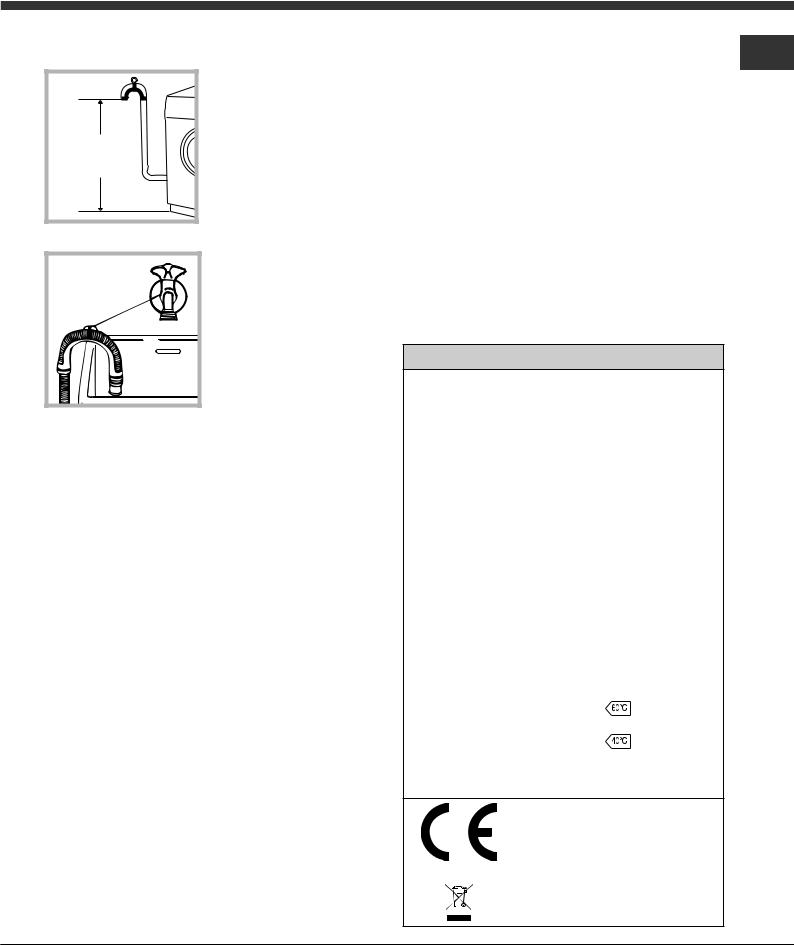
Connecting the drain hose
65 - 100 cm |
Connect the drain hose to drain duct piping or a wall drain located between 65 and 100 cm above the floor, making sure it is not bent at all.
Alternatively, rest the drain hose on the side of a washbasin or bathtub, fastening the duct supplied to the tap (see figure).
The free end of the hose should not be underwater.
! We advise against the use of hose extensions; if it is absolutely necessary, the extension must have the same diameter as the original hose and must not exceed 150 cm in length.
Electrical connections
Before plugging the appliance into the electricity socket, make sure that:
•the socket is earthed and complies with all applicable laws;
•the socket is able to withstand the maximum power load of the appliance as indicated in the Technical data table (see opposite);
•the power supply voltage falls within the values indicated in the Technical data table
(see opposite);
•the socket is compatible with the plug of the appliance. If this is not the case, have the socket or the plug replaced.
!The machine must not be installed outdoors, even in covered areas. It is extremely dangerous to leave the appliance exposed to rain, storms and other weather conditions.
!The mains socket must remain within easy reach after the washing machine has been installed.
! Do not use extension cords or multiple
sockets. EN
!The cable should not be bent or compressed.
!The power supply cable and plug must only be replaced by authorised technicians.
Warning! The company shall not be held responsible in the event that these regulations are not respected.
Technical data
Model |
AQ113DA 697 |
|
|
|
width 59.5 cm |
|
|
Dimensions |
height 85 cm |
|
|
|
depth 64,5 cm |
|
|
Capacity |
from 1 to 11 kg |
|
|
|
|
||
Electrical |
please refer to the technical |
||
data plate fixed to the ma- |
|||
connections |
|||
chine |
|
||
|
|
||
|
maximum pressure |
||
Water con- |
1 MPa (10 bar) |
|
|
minimum pressure |
|||
nections |
0.05 MPa (0.5 bar) |
||
|
drum capacity 71 litres |
||
|
|
||
Spin speed |
up to 1600 rotations per |
||
minute |
|
||
Test wash |
|
|
|
cycles in |
|
|
|
accordan- |
programme |
; |
|
ce with |
Cotton standard 60°C. |
||
directives |
programme |
; |
|
1061/2010 |
Cotton standard 40°C. |
||
and |
|
|
|
1015/2010 |
|
|
|
This appliance conforms to the following EC Directives:
-2004/108/EC (Electromagnetic Compatibility)
-2006/95/EC (Low Voltage)
- 2012/19/EU
3
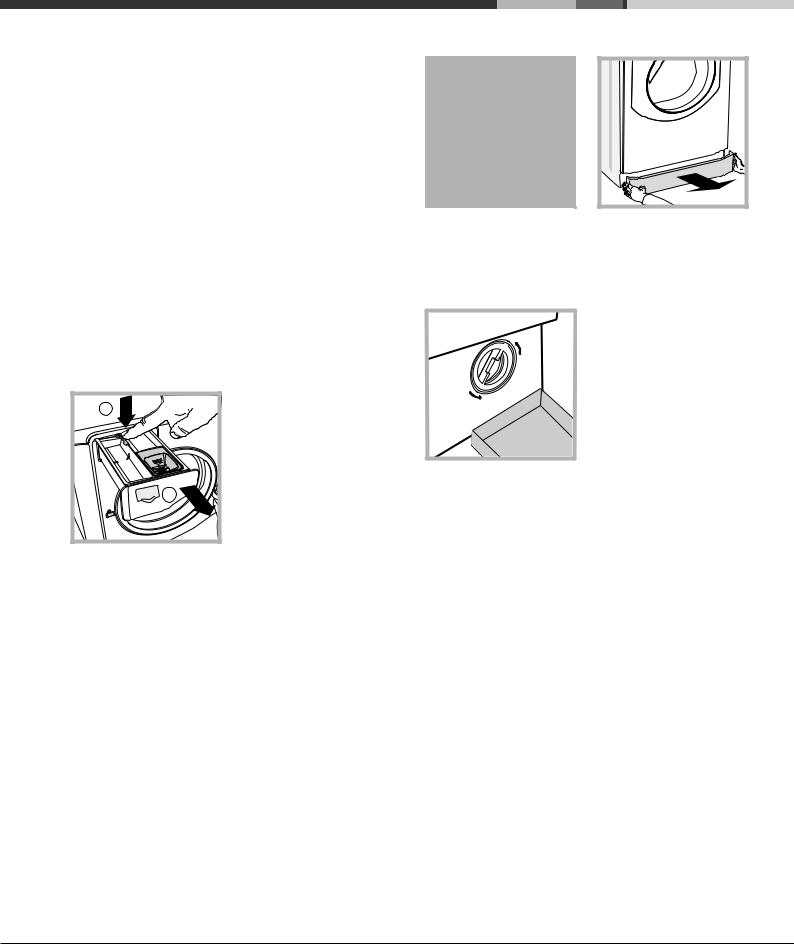
Care and maintenance
|
Cutting off the water and |
|
EN |
||
electricity supplies |
||
|
• Turn off the water tap after every wash cycle. |
|
|
This will limit wear on the hydraulic system in |
|
|
the machine and help to prevent leaks. |
|
|
• Unplug the appliance when cleaning it and |
|
|
during all maintenance work. |
Cleaning the machine
The outer parts and rubber components of the appliance can be cleaned using a soft cloth soaked in lukewarm soapy water. Do not use solvents or abrasives.
Cleaning the detergent dispenser drawer
1 |
1 |
2 |
2 |
To remove the drawer, press lever (1) and pull the drawer outwards (2)
(see figure).
Wash it under running water; this procedure should be repeated frequently.
Caring for your appliance drum
•Always leave the door ajar to prevent unpleasant odours from forming.
Cleaning the pump
The washing machine is fitted with a selfcleaning pump which does not require any maintenance. Sometimes, small items (such as coins or buttons) may fall into the protective pre-chamber at the base of the pump.
! Make sure the wash cycle has finished and unplug the appliance.
To access the pre-chamber:
1. take off the cover panel on the front of the machine by first pressing it in the centre and then pushing downwards on both sides until you can remove it (see figures);
2. position a container so that it will collect the water which flows out (approximately 1.5 l)
(see figure);
3. unscrew the lid by rotating it in an anticlockwise direction (see figure);
4.clean the inside thoroughly;
5.screw the lid back on;
6.reposition the panel, making sure the hooks are securely in place before you push it onto the appliance.
Checking the water inlet hose
Check the inlet hose at least once a year. If there are any cracks, it should be replaced immediately: during the wash cycles, water pressure is very strong and a cracked hose could easily split open.
4
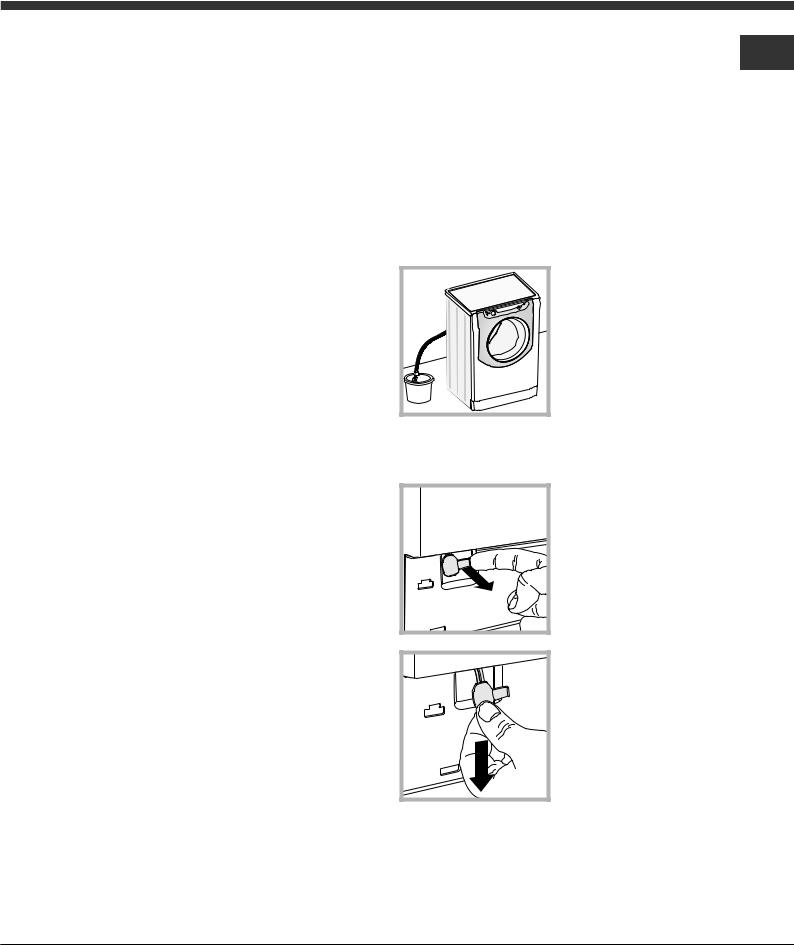
Precautions and tips
! The machine was designed and constructed in accordance with international safety regulations. The following information is provided for safety reasons and must therefore be read carefully.
General safety
• This appliance was designed for domestic use only.
• This appliance can be used by children aged from 8 years and above and persons with reduced physical, sensory or mental capabilities or lack of experience and knowledge if they have been given supervision or instruction concerning use of the appliance in a safe way and understand the hazards involved. Children shall not play with the appliance. Cleaning and user maintenance shall not be made by children without supervision.
•Do not touch the machine when barefoot or with wet or damp hands or feet.
•Do not pull on the power supply cable when unplugging the appliance from the electricity socket. Hold the plug and pull.
•Do not touch the drained water as it may reach extremely high temperatures.
•Never force the porthole door. This could damage the safety lock mechanism designed to prevent accidental opening.
•If the appliance breaks down, do not under any circumstances access the internal mechanisms in an attempt to repair it yourself.
•Always keep children well away from the appliance while it is operating.
•If it must be moved, proceed with the help of two or three people and handle it with the utmost care. Never try to do this alone, because the appliance is very heavy.
•Before loading laundry into the washing machine, make sure the drum is empty.
Load balancing system
Before every spin cycle, to avoid excessive vibrations before every spin and to distribute the load in a uniform manner, the drum rotates continuously at a speed which is slightly greater than the washing rotation speed. If, after several attempts, the load is not balanced correctly, the machine spins at a reduced spin speed. If the load is excessively unbalanced, the washing machine performs the distribution process instead of spinning. To encourage improved load distribution and balance, we recommend small and large garments are mixed in the load.
Disposal
•Disposing of the packaging materials: observe local regulations so that the packaging may be re-used.
•The European Directive 2012/19/EU relating to Waste Electrical and Electronic Equipment (WEEE) states that household appliances should not be disposed of using the normal solid urban waste cycle. Exhausted appliances should be collected separately in order to
optimise the cost of re-using and recycling the materials
inside the machine, while preventing potential damage
to the atmosphere and to public health. EN The crossed-out dustbin is marked on all products
to remind the owner of their obligations regarding separated waste collection.
For more information relating to the correct disposal of household appliances, owners should contact their local authorities or appliance dealer.
Opening the porthole door manually
In the event that it is not possible to open the porthole door due to a powercut, and if you wish to remove the laundry, proceed as follows:
1. remove the plug from the electrical socket.
2. make sure the water level inside the machine is lower than the door opening; if
it is not, remove excess water using the drain hose, collecting it in a bucket as indicated in the figure.
3. remove the cover panel on the lower front part of the washing machine (see overleaf).
4. pull outwards using the tab as indicated in the figure, until the plastic tie-rod is freed from its stop position; pull downwards until you hear a “click”, which indicates that the door is now unlocked.
5. open the door; if this is still not possible repeat the procedure.
6. reposition the panel, making sure the hooks are securely in place before you push it onto the appliance.
5
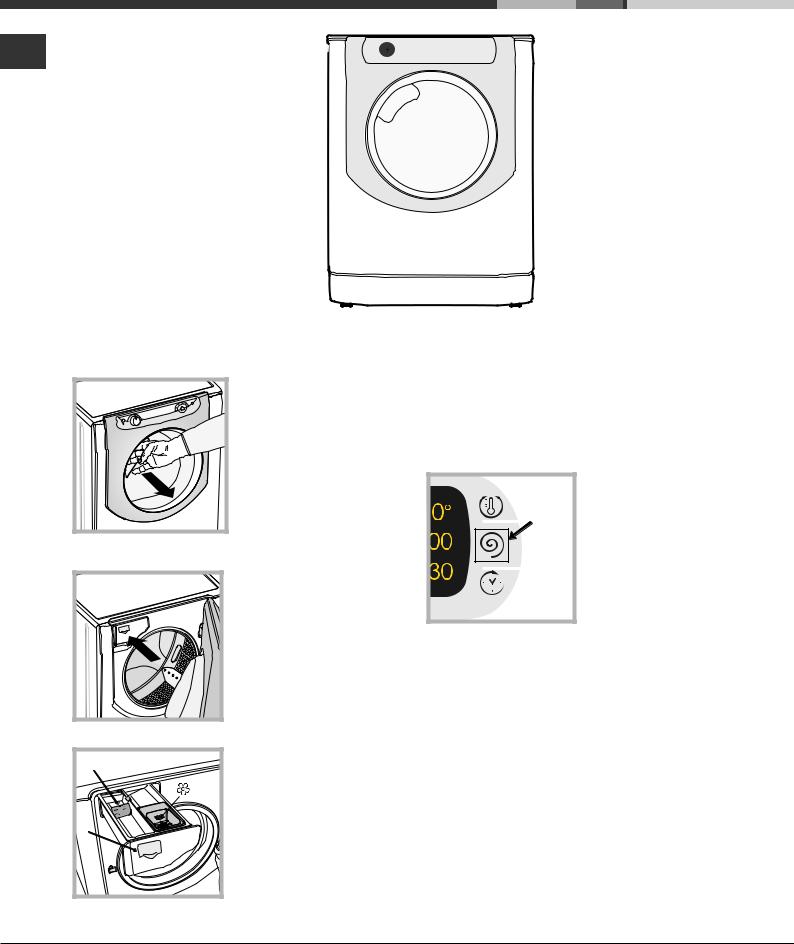
Description of the machine
EN
PORTHOLE DOOR
PORTHOLE DOOR
HANDLE
KICK STRIP
PORTHOLE DOOR
Always use the handle to open the porthole door (see figure).
DETERGENT DISPENSER DRAWER
The detergent dispenser
drawer is located inside
the machine and can be accessed by opening the door.
For more information on
detergent measures, please
refer to the chapter entitled
“Detergents and laundry”.
CONTROL
PANEL
 washing additives compartment: for fabric softener or liquid additives. We recommend that the maximum level indicated by the grille is not exceeded, and that concentrated fabric softeners are diluted.
washing additives compartment: for fabric softener or liquid additives. We recommend that the maximum level indicated by the grille is not exceeded, and that concentrated fabric softeners are diluted.
TOUCH CONTROL PANEL
To adjust the settings, gently press the icon inside the sensitive (touch control) area as illustrated in the figure.
Standby mode
This washing machine, in compliance with new energy saving regulations, is fitted with an automatic standby system which is enabled after about 30 minutes if no activity is detected. Press the ON-OFF  button briefly and wait for the machine to start up again.
button briefly and wait for the machine to start up again.
|
A |
|
1 |
B |
2 |
1.pre-wash compartment: use powder detergent.
2.main wash compartment: If liquid detergent is used, it is recommended that the removable plastic partition A
(supplied) be used for proper dosage.If powder detergent is used, place the partition into slot B.
Consumption in off-mode: 0,5 W Consumption in Left-on: 0,5 W
6

|
|
|
|
|
|
|
|
|
|
|
|
|
Touch control panel |
|
|
|
|
START/PAUSE button |
|
||||||
|
|
|
|
EN |
||||||||
|
|
|
|
|
|
SPIN |
with indicator light |
WASH |
||||
|
|
|
|
|
|
|
|
|
|
|||
WASH CYCLE |
|
|
|
M1 |
button |
ECO |
|
CYCLE |
|
|||
|
|
|
|
|
||||||||
SELECTOR knob |
M2 |
TEMPERATURE |
|
|
PHASE |
|
||||||
|
|
|
indicator light |
|
|
|||||||
|
|
|
|
|
button |
|
|
icons |
|
|||
|
|
|
|
|
|
|
|
|
||||
|
|
|
|
|
|
|
|
|
|
|
||
|
|
|
|
|
|
|
|
|
|
|
|
|
|
|
|
|
|
|
|
|
|
|
|
|
|
|
|
|
|
|
|
|
|
|
|
|
|
|
|
|
|
|
|
|
|
|
|
|
|
|
|
|
|
|
|
|
|
|
|
|
|
|
|
|
DISPLAY
|
|
|
|
|
|
|
|
CONTROL PANEL LOCK |
|
|
|
|
|
|
|
|
|
|
|
|
|
|
|
|
|
|
Button with ON/OFF |
|
|
|
OPTION |
|
|
|
|
M3 |
|
DELAYED START |
button with indicator light |
|||||
|
buttons |
|||||||
indicator light |
|
|||||||
|
|
|
|
button |
|
|||
|
|
|
|
|
|
|||
|
|
|
|
|
|
|
DOOR LOCKED indicator light |
|
Button with  ON/OFF indicator light: press this briefly to switch the machine on or off. The green indicator light indicates that the machine is switched on. To switch off the washing machine during the wash cycle, press and hold the button for approximately 3 seconds; if the button is pressed briefly or accidentally the machine will not switch off. If the machine is switched off during a wash cycle, this wash cycle will be cancelled.
ON/OFF indicator light: press this briefly to switch the machine on or off. The green indicator light indicates that the machine is switched on. To switch off the washing machine during the wash cycle, press and hold the button for approximately 3 seconds; if the button is pressed briefly or accidentally the machine will not switch off. If the machine is switched off during a wash cycle, this wash cycle will be cancelled.
WASH CYCLE SELECTOR knob: may be turned in either direction. To select the most suitable wash cycle, please refer to the “Table of wash cycles”.
The knob will not move during the wash cycle.
M1-M2-M3 buttons: press and hold one of the buttons to store a cycle with your own set preferences in the memory of the machine. To recall a previously-stored cycle, press the corresponding button.
TEMPERATURE  button: press to modify or exclude the temperature setting; the value selected will appear on the display above (see “Running a wash cycle”).
button: press to modify or exclude the temperature setting; the value selected will appear on the display above (see “Running a wash cycle”).
SPIN CYCLE  button: press to modify or exclude the spin cycle; the value selected will appear on the display above (see “Running a wash cycle”).
button: press to modify or exclude the spin cycle; the value selected will appear on the display above (see “Running a wash cycle”).
DELAYED START  button: press to set a delayed start for the selected wash cycle; the set delay time will appear on the display above (see “Running a wash cycle”).
button: press to set a delayed start for the selected wash cycle; the set delay time will appear on the display above (see “Running a wash cycle”).
OPTION buttons: press to select the available options. The indicator light corresponding to the selected option will remain lit (see “Running a wash cycle”).
WASH CYCLE PHASE icons: these illuminate to indicate the progress of the wash cycle (Wash  – Rinse
– Rinse  – Spin
– Spin  – Drain
– Drain  ). The text
). The text
 lights up when the cycle is complete.
lights up when the cycle is complete.
START/PAUSE button with indicator light: when the green indicator light flashes slowly, press the button to start a wash cycle. Once the cycle has begun the indicator light will remain lit in a fixed manner. To pause the wash cycle, press the button
again; the indicator light will flash in an orange colour. If the “Door locked”  indicator light is switched off, the door may be opened. To start the wash cycle from the point at which it was interrupted, press the button again.
indicator light is switched off, the door may be opened. To start the wash cycle from the point at which it was interrupted, press the button again.
DOOR LOCKED  indicator light: indicates that the porthole door is locked. To open the door, pause the wash cycle (see “Running a wash cycle”).
indicator light: indicates that the porthole door is locked. To open the door, pause the wash cycle (see “Running a wash cycle”).
CONTROL PANEL LOCK  button with indicator light: to activate or deactivate the control panel lock, press and hold the button for approximately 2 seconds. when the indicator light is illuminated, the control panel is locked (apart from the ON/OFF button). This means it is possible to prevent wash cycles from being modified accidentally, especially where there are children in the home.
button with indicator light: to activate or deactivate the control panel lock, press and hold the button for approximately 2 seconds. when the indicator light is illuminated, the control panel is locked (apart from the ON/OFF button). This means it is possible to prevent wash cycles from being modified accidentally, especially where there are children in the home.
ECO indicator light: the
 icon lights up when, after altering the washing parameters, an energy saving of at least 10% is made. Furthermore, before the machine enters “Standby” mode, the icon will light up for a few seconds; when the machine is switched off the estimated energy saving will be around the 80% mark.
icon lights up when, after altering the washing parameters, an energy saving of at least 10% is made. Furthermore, before the machine enters “Standby” mode, the icon will light up for a few seconds; when the machine is switched off the estimated energy saving will be around the 80% mark.
CHANGE LANGUAGE.
The first time the machine is switched on, the first language will flash on the display. The “ “, “OK” and “V” symbols will appear on the display, in line with the 3 buttons on the righthand side. The languages change automatically every 3”; alternatively, they can be changed by pressing the buttons next to the “
“, “OK” and “V” symbols will appear on the display, in line with the 3 buttons on the righthand side. The languages change automatically every 3”; alternatively, they can be changed by pressing the buttons next to the “ “ and “V” symbols. Use the “OK” button to confirm the language, which will be set after 2”. If no buttons are pressed, the automatic language change will begin again after 30”.
“ and “V” symbols. Use the “OK” button to confirm the language, which will be set after 2”. If no buttons are pressed, the automatic language change will begin again after 30”.
To change the language, switch the machine on and off again; in the 30” time period after it has been switched off, press and hold the temperature  +spin
+spin  +delayed
+delayed  start buttons simultaneously for 5’’. A short sound alert will be emitted and the set language will flash on the display. Press the buttons next to the “
start buttons simultaneously for 5’’. A short sound alert will be emitted and the set language will flash on the display. Press the buttons next to the “ “ and “V” symbols to change the language. Use the button next to the “OK” symbol to confirm the language, which will be set after 2”. If no buttons are pressed, the language set previously will be displayed after 30”. Switch on the machine.
“ and “V” symbols to change the language. Use the button next to the “OK” symbol to confirm the language, which will be set after 2”. If no buttons are pressed, the language set previously will be displayed after 30”. Switch on the machine.
7

Running a wash cycle
WARNING: before you use the washing machine for the EN first time, run a wash cycle with detergent and no laundry,
using the 90° cottons cycle without pre-wash.
1.SWITCH THE MACHINE ON. Press the  button. All the indicator lights will illuminate for 1 second and the text AQUALTIS will appear on the display; the indicator
button. All the indicator lights will illuminate for 1 second and the text AQUALTIS will appear on the display; the indicator
light corresponding to the  button will then remain lit in a constant manner and the START/PAUSE indicator light will flash.
button will then remain lit in a constant manner and the START/PAUSE indicator light will flash.
2.SELECT THE PROGRAMME. Turn the PROGRAMME KNOB left or right, until the required programme has been selected; the name of the programme will appear on the display. A temperature and spin speed is set for each programme; these may be adjusted. The cycle duration will also appear on the display.
3.LOAD THE LAUNDRY. Open the porthole door. Load the laundry, making sure you do not exceed the maximum load value indicated in the table of wash cycles on the following page.
4.MEASURE OUT THE DETERGENT. Pull out the detergent dispenser drawer and pour the detergent into the relevant compartments as described in “Description of the machine”.
5.CLOSE THE PORTHOLE DOOR.
6.CUSTOMISE THE WASH CYCLE. Use the relevant buttons on the control panel:
 Modify the temperature and/or spin speed.
Modify the temperature and/or spin speed.
The machine automatically displays the maximum temperature and spin speed values set for the selected cycle, or the most recently-used settings if they are compatible with the selected cycle. The temperature can be decreased by pressing the 
 button, until the cold wash “OFF” setting is reached. The spin speed may be progressively reduced by pressing the
button, until the cold wash “OFF” setting is reached. The spin speed may be progressively reduced by pressing the  button, until it is completely excluded “OFF”. If these buttons are pressed again, the maximum values are restored.
button, until it is completely excluded “OFF”. If these buttons are pressed again, the maximum values are restored.
! Exception: if the  programme is selected, the temperature can be increased up to a value of 90°C.
programme is selected, the temperature can be increased up to a value of 90°C.


 Setting a delayed start.
Setting a delayed start.
To set a delayed start for the selected cycle, press the corresponding button repeatedly until the required delay period has been reached. During the setting procedure, the delay period and the text “Starts in:” will be displayed, along with the flashing  symbol. After the delayed start has been set, the
symbol. After the delayed start has been set, the 

 symbol will remain fixed on the display, which will also indicate the duration of the selected cycle with the text “Ends in:” and the cycle duration. Press the DELAYED START button just once to display the delay time set previously.
symbol will remain fixed on the display, which will also indicate the duration of the selected cycle with the text “Ends in:” and the cycle duration. Press the DELAYED START button just once to display the delay time set previously.
After the countdown has begun, the display will show the text “Starts in:” and the delay period. Once the set delay time has elapsed, the machine will begin its cycle and the display will show “Ends in:” and the time remaining until the end of the cycle.
To remove the delayed start option, press the button until the display shows the text OFF; the 

 symbol will disappear.
symbol will disappear.





 Modify the cycle settings.
Modify the cycle settings.
•Press the button to activate the option; the name of the option will then appear on the display and the corresponding indicator light will illuminate.
•Press the button again to deactivate the option; the name of the option will then appear on the display followed by the text OFF, and the corresponding indicator light will switch off.
!If the selected option is not compatible with the selected wash cycle, this incompatibility will be signalled by the flashing of the indicator light and a sound alert (3 beeps); the option will not be activated.
!If the selected option is not compatible with another option that has been selected previously, the indicator light corresponding to the first option selected will flash and only the second option will be activated; the indicator light corresponding to the button will remain lit in a constant manner.
!The options may affect the recommended load value and/
or the duration of the cycle.
7.START THE PROGRAMME. Press the START/PAUSE button. The corresponding indicator light remains lit
in a fixed manner and the porthole door locks (the  DOOR LOCKED indicator light illuminates). The icons corresponding to the wash cycle phases will light up during the cycle to indicate which phase is currently in progress.
DOOR LOCKED indicator light illuminates). The icons corresponding to the wash cycle phases will light up during the cycle to indicate which phase is currently in progress.
To change a wash cycle once it has already started, pause the washing machine by pressing the START/ PAUSE button; then select the desired cycle and press the START/PAUSE button again.
To open the door during a wash cycle, press the START/
PAUSE button; if the DOOR LOCKED  indicator light is switched off you may open the door. Press the START/ PAUSE button again to restart the wash cycle from the point at which it was interrupted.
indicator light is switched off you may open the door. Press the START/ PAUSE button again to restart the wash cycle from the point at which it was interrupted.
8.THE END OF THE WASH CYCLE. This is indicated by the illuminated text END. The porthole door may be opened immediately. If the START/PAUSE indicator light is flashing, press the button to end the cycle. Open the door, unload the laundry and switch off the machine.
! If you wish to cancel a cycle which has already begun, press and hold the  button until the cycle stops and the machine switches off.
button until the cycle stops and the machine switches off.
Bag for quilts, curtains and delicate garments
The Aqualtis washing machine makes it easier for you to wash even the most valuable and delicate garments in complete confidence thanks to the special bag which protects the laundry (this is supplied with the machine).
We recommend that the bag is used every time you wash quilts and padded items with an outer layer made using synthetic material.
8
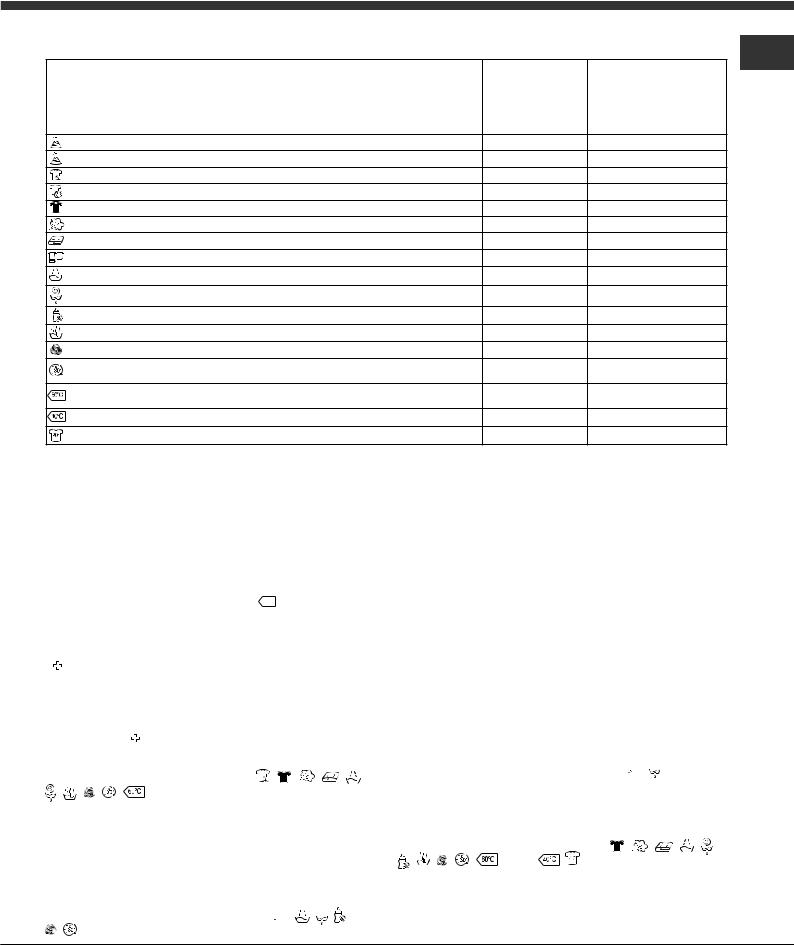
Wash cycles and options
Table of wash cycles
Icon |
|
Max. |
Max. |
|
Description of the wash cycle |
temp. |
speed |
||
|
||||
|
|
(°C) |
(rpm) |
|
|
Synthetics Resistant |
60° |
800 |
|
|
Synthetics Resistant (4) |
40° |
800 |
|
|
Whites |
60° |
1600 |
|
|
Coloureds |
40° |
1600 |
|
|
Darks |
30° |
800 |
|
|
Steam Refresh |
- |
- |
|
|
Duvets: for down-stuffed garments. |
30° |
1200 |
|
|
Bed&Bath for bedlinen and towels. |
60° |
1600 |
|
|
Rinse |
- |
1600 |
|
|
Spin and Pump out |
- |
1600 |
|
|
Anti Allergy |
60° |
1600 |
|
|
Ultradelicates |
30° |
0 |
|
|
Wool: for wool, cashmere, etc. |
40° |
800 |
|
|
Mix 30': to refresh lightly soiled garments quickly (not suitable for |
30° |
800 |
|
|
wool, silk and clothes which require washing by hand). |
|||
|
60° |
|
||
|
Cotton Standard 60°C (1): heavily soiled whites and resistant colours. |
1600 |
||
|
(Max. 90°) |
|||
|
Cotton Standard 40°C (2): lightly soiled whites and delicate colours. |
40° |
1600 |
|
|
Cotton Standard 20°C: lightly soiled whites and delicate colours. |
20° |
1600 |
|
|
|
|
|
Detergent and additives
Prewash |
Wash |
Fabric softener |
|
|
|
|
|
|
|
|
|
|
|
|
- |
|
|
- |
- |
- |
- |
|
|
|
|
|
- |
- |
|
- |
- |
- |
- |
|
|
- |
|
|
- |
|
|
- |
|
|
(3) |
|
|
- |
|
|
- |
|
|
|
|
|
EN
Max. load (kg) |
Residual dampness % |
Energy consumption kWh |
Total water lt |
Cycle duration |
5,5 |
48 |
1,20 |
74 |
120’ |
5,5 |
48 |
0,70 |
72 |
100’ |
6 |
- |
- |
- |
190’ |
6 |
44 |
0,99 |
92 |
125’ |
6 |
- |
- |
- |
80’ |
2 |
- |
- |
- |
20’ |
3,5 |
- |
- |
- |
145’ |
11 |
- |
- |
- |
160’ |
11 |
- |
- |
- |
49’ |
11 |
- |
- |
- |
16’ |
6 |
- |
- |
- |
205’ |
1 |
- |
- |
- |
80’ |
2,5 |
- |
- |
- |
100’ |
4 |
71 |
0,21 |
41 |
30’ |
11 |
44 |
1,38 |
83 |
205’ |
11 |
44 |
1,19 |
90 |
195’ |
11 |
- |
- |
- |
175’ |
|
|
|
|
|
The length of cycle shown on the display or in this booklet is an estimation only and is calculated assuming standard working conditions. The actual duration can vary according to factors such as water temperature and pressure, the amount of detergent used, the amount and type of load inserted, load balancing and any wash options selected.
Note: 10 minutes after the START, the machine will recalculate the time remaining until the end of the wash cycle on the basis of the load inside it; this value will then be shown on the display.
1) Test wash cycle in compliance with directive 1061/2010: set wash cycle  with a temperature of 60°C.
with a temperature of 60°C.
This cycle is designed for cotton loads with a normal soil level and is the most efficient in terms of both electricity and water consumption; it should be used for garments which can be washed at 60°C. The actual washing temperature may differ from the indicated value.
2) Test wash cycle in compliance with directive 1061/2010: set wash cycle  with a temperature of 40°C.
with a temperature of 40°C.
This cycle is designed for cotton loads with a normal soil level and is the most efficient in terms of both electricity and water consumption; it should be used for garments which can be washed at 40°C. The actual washing temperature may differ from the indicated value.
3) At 60 °C the “Prewash” function cannot be selected.
For all Test Institutes:
2) Long wash cycle for cottons: set wash cycle 
4) Long wash cycle for synthetics: set wash cycle
 with a temperature of 40°C.
with a temperature of 40°C.  with a temperature of 40°C.
with a temperature of 40°C.
Wash options





 Steam Hygiene
Steam Hygiene
This option enhances washing performance by generating steam during the wash cycle that eliminates any bacteria from fibres while treating them at the same time. Place the laundry in the drum, choose a compatible programme and select option “




 “.
“.
! The steam generated during washing machine operation may cause the porthole door to become hazy.
! It cannot be used in conjunction with , , |
, |
, , |
|
, , , , |
(90°). |
|
|
 Easy Iron
Easy Iron
By selecting this option, the wash and spin cycles will be modified in order to reduce the formation of creases.
At the end of the cycle the washing machine drum will rotate slowly; the “Easy Iron” and START/PAUSE indicator lights will flash. To end the cycle press the START/PAUSE button or the “Easy Iron” button.
! It cannot be used in conjunction with  ,
, 



 , ,
, ,  , ,
, ,
, .
 Extra rinse
Extra rinse
By selecting this option, the efficiency of the rinse is increased and optimal residual detergent removal is guaranteed. It is particularly useful for skin which is sensitive to detergents. We recommend this option is used with a full load of washing, or when a large amount of detergent is required.
! It cannot be used in conjunction with  ,
,  ,
,  ,
, ,
,  ,
, .
.


 Prewash
Prewash
If this function is selected, the pre-wash cycle will run; this is useful for removing stubborn stains.
N.B.: put the detergent in the relevant compartment.
! It cannot be used in conjunction with , |
, |
, , , |
||
, , , , |
(60°), |
, . |
|
|
9
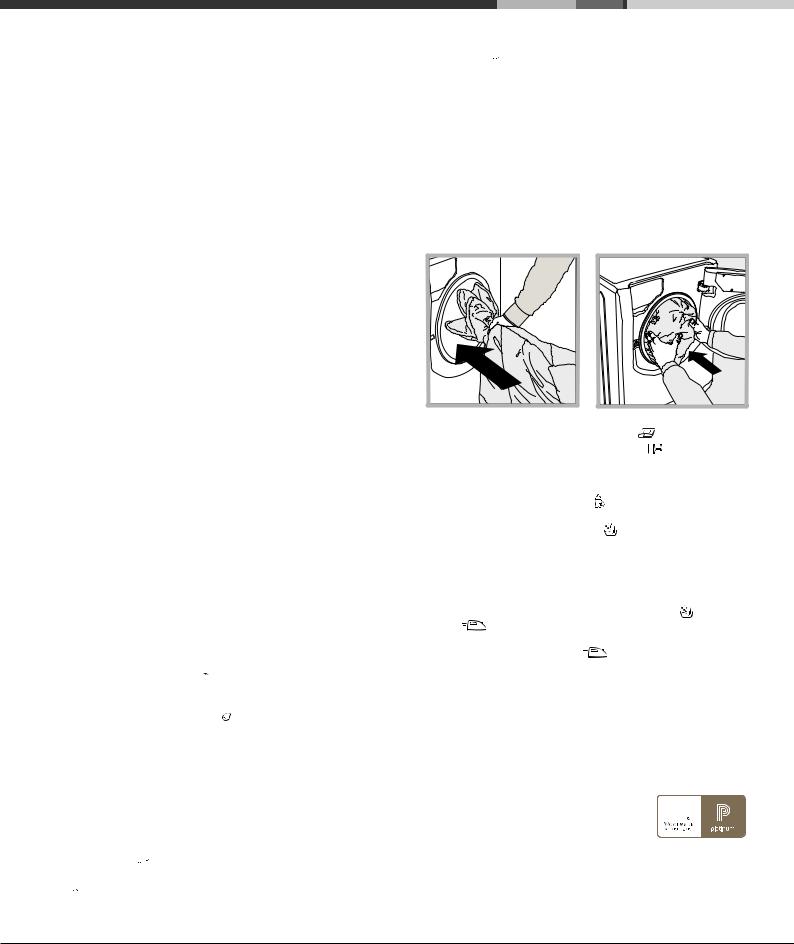
Detergents and laundry
EN |
Detergent |
|
The type and quantity of detergent required depend on |
||
|
||
|
the type of fabric you are washing (cotton, wool, silk, etc.), |
|
|
as well as its colour, the washing temperature, the level of |
|
|
soiling and the hardness of the water in the area. |
|
|
Measuring out the detergent carefully will avoid wastage |
|
|
and help to protect the environment: although they are |
|
|
biodegradable, detergents still contain ingredients which alter |
|
|
the balance of nature. |
|
|
We recommend the following: |
|
|
• use powder detergents for white cotton garments and |
|
|
pre-washing. |
|
|
• use liquid detergents for delicate cotton garments and for |
|
|
all low-temperature wash cycles. |
|
|
• use gentle liquid detergents for wool and silk garments. |
|
|
Thedetergentshouldbepouredintotherelevantcompartment-or |
|
|
the dispenser placed directly inside the drum - before the wash |
|
|
cycle begins. In the latter case, it will not be possible to select the |
|
|
Cottons with pre-wash cycle. |
|
|
! Do not use hand washing detergents because these create |
|
|
too much foam. |
|
|
! Use powder detergent for white cotton garments, for pre- |
|
|
washing, and for washing at temperatures over 60°C. |
|
|
! Follow the instructions given on the detergent packaging. |
Preparing the laundry
•Shake out the garments before loading them into the machine.
•Divide the laundry according fabric type (symbol on the washing instruction label) and colour, making sure you separate the coloured garments from the white ones;
•Empty all pockets and check the buttons;
•Do not exceed the values listed in the “Table of wash cycles”, which refer to the weight of the laundry when dry.
How much does your laundry weigh?
1 sheet |
400-500 g |
1 pillowcase |
150-200 g |
1 tablecloth |
400-500 g |
1 bathrobe |
900-1200 g |
1 towel |
150-250 g |
1 pair of jeans |
400-500 g |
1 shirt |
150-200 g |
Washing recommendations
Whites: use this cycle  to wash white clothes. The programme is designed to maintain the brightness of white clothes over time.
to wash white clothes. The programme is designed to maintain the brightness of white clothes over time.
Coloureds: use this cycle  to wash bright coloured clothes. The programme is designed to maintain bright colours over time.
to wash bright coloured clothes. The programme is designed to maintain bright colours over time.
Darks: Use cycle  to wash dark-coloured garments. This programme is designed to maintain dark colours over time. We recommend using a liquid detergent for the best results when washing dark-coloured garments.
to wash dark-coloured garments. This programme is designed to maintain dark colours over time. We recommend using a liquid detergent for the best results when washing dark-coloured garments.
Steam Refresh: this programme refreshes garments by removing bad odours and relaxing the fibres (2 kg, roughly 3 items). Insert dry items only (that are not dirty) and select
programme “ “. The garments will be damp once the cycle is completed, so we recommend hanging them to dry. The “
“. The garments will be damp once the cycle is completed, so we recommend hanging them to dry. The “ 


 “ programme makes ironing easier. Moreover, with the “Steam Perfume” laundry balls, your favourite perfume can be added to your laundry. Place a few drops of perfume on the sponge contained inside the laundry ball, close it and insert it
“ programme makes ironing easier. Moreover, with the “Steam Perfume” laundry balls, your favourite perfume can be added to your laundry. Place a few drops of perfume on the sponge contained inside the laundry ball, close it and insert it
into the drum together with the laundry. Then launch the specific programme “


 “. At the end of the cycle, garments will be relaxed and fragrant.
“. At the end of the cycle, garments will be relaxed and fragrant.
!Not recommended for wool or silk garments.
!Do not add too much perfume to the sponge in order to avoid it dripping.
!Do not add softeners or detergents.
Duvets: to wash double or single duvets (the weight of which should not exceed 3,5 kg), cushions or clothes padded with goose down such as puffa jackets, use the special  wash cycle. We recommend that duvets are placed in the drum with their edges folded inwards (see figure) and that no more than ¾ of the total volume of the drum is used. To achieve the best results, we recommend that a liquid detergent is used and placed inside the detergent dispenser drawer.
wash cycle. We recommend that duvets are placed in the drum with their edges folded inwards (see figure) and that no more than ¾ of the total volume of the drum is used. To achieve the best results, we recommend that a liquid detergent is used and placed inside the detergent dispenser drawer.
Quilts: to wash quilts with a synthetic outer layer, use the
bag provided and set the wash cycle to |
. |
Bedlinen and towels: Use programme |
to wash bed |
linen and towels in one single cycle: it optimises softener performance and helps you save time and energy. We recommend the use of powder detergent
Anti Allergy: use programme |
to remove major allergens |
such as pollen, mites, cat’s and dog’s hair. |
|
Ultradelicates: use programme |
to wash very delicate |
garments having strasses or sequins.
We recommend turning the garments inside out before washing and placing small items into the special bag for washing delicates. Use liquid detergent on delicate garments for best results.
To wash Silk garments and Curtains (these should be folded
and placed inside the bag provided), select cycle |
and then |
||
option |
(in this case it will also be possible to enable the |
||
“Extra Rinse” option); the machine will end the cycle while |
|||
the laundry is soaking and the |
indicator light will flash. To |
||
drain the water so that the laundry may be removed, press the START/PAUSE button or the  button.
button.
Wool: the wool wash cycle on this Hotpoint-Ariston machine has been tested and approved by The Woolmark Company for washing wool garments labelled as hand washable provided that the garments are washed according to the instructions on the garment label and those issued by the manufacturer of this washing machine. Hotpoint-Ariston is the first washing machine brand to be approved by The Woolmark Company for Apparel CarePlatinum for its washing performance and consumption of energy and water. (M1135) 


In UK, Eire, Hong Kong and India the Woolmark trade mark is a Certification trade mark.
Cotton Standard 20°C: ideal for heavily soiled cotton loads. The effective performance levels achieved at cold temperatures, which are comparable to washing at 40°, are guaranteed by a mechanical action which operates at varying speed, with repeated and frequent peaks.
10

Trouble shooting
Your washing machine could occasionally fail to work. Before contacting the Technical Assistance Centre (see “Assistance”), |
EN |
make sure that the problem cannot be solved easily using the following list. |
Problem:
The washing machine does not switch on.
Possible causes / Solutions:
•The appliance is not plugged into the socket fully, or not enough to make contact.
•There is no power in the house.
The wash cycle does not start.
•The door is not closed properly.
•The START/PAUSE button has not been pressed.
•The water tap has not been opened.
•A delayed start has been set.
The washing machine does not fill with water.
The washing machine door remains locked.
The machine continuously fills with water and drains.
•The water inlet hose is not connected to the tap.
•The hose is bent.
•The water tap has not been opened.
•There is no water supply in the house.
•The pressure is too low.
•The START/PAUSE button has not been pressed.
•If you have selected the  function, at the end of the cycle the washing machine drum will rotate slowly; to end the cycle press the START/PAUSE button or the
function, at the end of the cycle the washing machine drum will rotate slowly; to end the cycle press the START/PAUSE button or the  button.
button.
•The drain hose is not fitted at a height between 65 and 100 cm from the floor (see “Installation”).
•The free end of the hose is under water (see “Installation”).
•If the dwelling is on one of the upper floors of a building, there may be problems relating to water drainage, causing the washing machine to fill with water and drain continuously. Special anti-draining valves are available in shops and help to prevent this inconvenience.
•The wall drainage system is not fitted with a breather pipe.
The washing machine does not drain or spin.
•The wash cycle does not include draining: Some wash cycles require the drain phase to be started manually (see “Wash cycles and options”).
•The “Easy iron” option is enabled: to complete the wash cycle, press the START/PAUSE button (“Wash cycles and options”).
•The drain hose is bent (see Installation).
•The drainage duct is clogged.
The machine vibrates a lot during the spin cycle.
The washing machine leaks.
•The drum was not unlocked correctly during installation (see “Installation”).
•The machine is not level (see “Installation” ).
•The machine is trapped between cabinets and walls (see “Installation”).
•The load is unbalanced (see “Detergents and laundry”).
•The water inlet hose is not screwed on properly (see “Installation”).
•The detergent dispenser is blocked (to clean it, see “Care and maintenance”).
•The drain hose is not fixed in place properly (see “Installation”).
The icons corresponding to the “Phase in progress” flash rapidly at the same time as the ON/OFF indicator light.
There is too much foam.
•Switch off the machine and unplug it, wait for approximately 1 minute and then switch it back on again. If the problem persists, contact the Technical Assistance Service.
•The detergent is not suitable for machine washing (it should display the text “for washing machines” or “hand and machine wash”, or the like).
•Too much detergent was used.
The washing machine door |
• Perform the manual unlocking procedure (see “Precautions and tips”). |
remains locked. |
|
! Note: to exit “Demo mode”, switch machine off, press and hold the two “START/PAUSE” 
 and “ON/OFF”
and “ON/OFF”  buttons simultaneously for 3 seconds.
buttons simultaneously for 3 seconds.
11

Assistance
|
|
|
|
|
|
|
|
Before calling for Assistance: |
|
||||
EN |
|
|||||
• Check whether you can solve the problem by yourself (see “Trouble shooting”); |
|
|||||
|
|
|||||
|
• Restart the wash cycle to check whether the problem has been solved; |
|
||||
|
|
|||||
|
• If it has not, contact the Authorised Technical Assistance Service. |
|
||||
|
! If the washing machine has been installed or used incorrectly, you will have to pay for the call-out service. |
|
||||
|
! Always request the assistance of authorised technicians. |
|
||||
Please have the following information to hand:
•the type of problem;
•the appliance model (Mod.);
•the serial number (S/N).
The above information can be found on the data plate located on the appliance itself.
12

Οδηγίες για την εγκατάσταση και τη |
|
χρήση |
ΠΛΥΝΤΗΡΙΟ ΡΟΥΧΩΝ |
GR
Ελληνικά
Περιεχόμενα |
|
GR |
|
|
|
Εγκατάσταση, 14-15
Αποσυσκευασία και οριζοντίωση Υδραυλικές και ηλεκτρικές συνδέσεις Τεχνικά στοιχεία
AQUALTIS
AQ113DA 697
Συντήρηση και φροντίδα, 16
Αποκλεισμός νερού και ηλεκτρικού ρεύματος Καθαρισμός της μηχανής Καθαρισμός του συρταριού απορρυπαντικών Φροντίδα του κάδου Καθαρισμός της αντλίας
Έλεγχος του σωλήνα τροφοδοσίας του νερού
Προφυλάξεις και συμβουλές, 17
Γενική ασφάλεια Σύστημα ισοστάθμισης του φορτίου Διάθεση
Χειρονακτικό άνοιγμα της πόρτας
Περιγραφή της μηχανής, 18-19
Πίνακας χειριστηρίων “touch control”
Πως διενεργείται ένας κύκλος πλυσίματος, 20
Προγράμματα και δυνατότητες, 21
Πίνακας Προγραμμάτων Δυνατότητες πλυσίματος
Απορρυπαντικά και μπουγάδα, 22
Απορρυπαντικό Προετοιμασία της μπουγάδας Συμβουλές πλυσίματος
Ανωμαλίες και λύσεις, 23
Υποστήριξη, 24
13
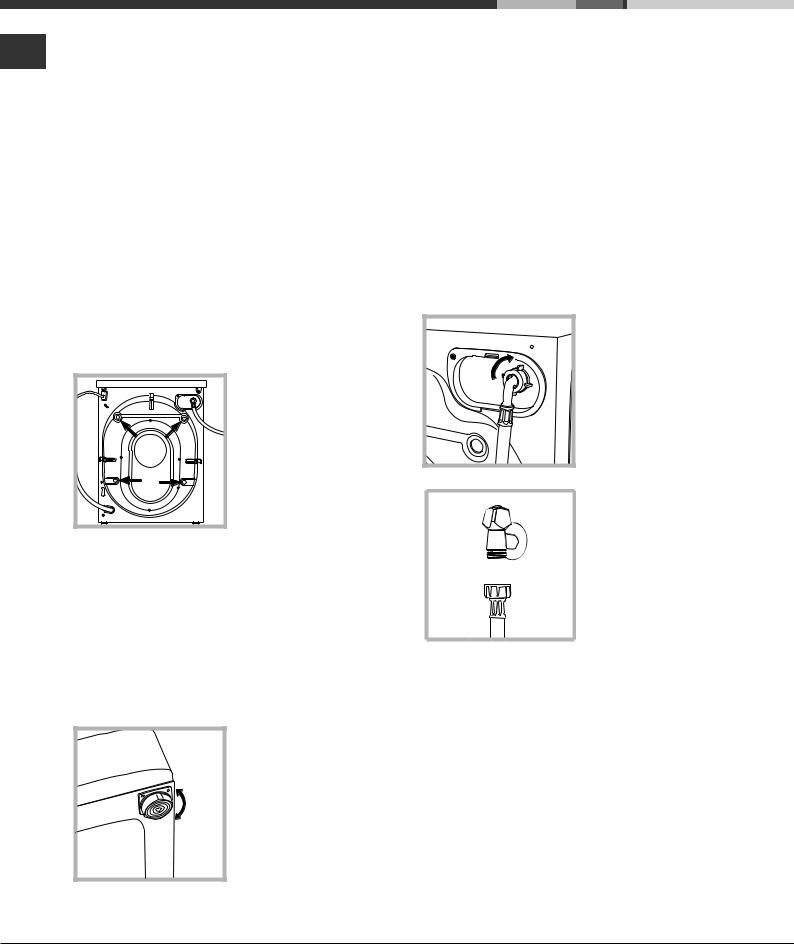
Εγκατάσταση
GR |
! Είναι σημαντικό να διατηρήσετε το |
|
εγχειρίδιο αυτό για να μπορείτε να το |
|
συμβουλεύεστε οποιαδήποτε στιγμή. Σε |
|
περίπτωση πώλησης, παραχώρησης ή |
|
μετακόμισης, βεβαιωθείτε ότι παραμένει μαζί |
|
με το πλυντήριο. |
|
! Διαβάστε προσεκτικά τις οδηγίες: |
|
υπάρχουν σημαντικές πληροφορίες για την |
|
εγκατάσταση, τη χρήση και την ασφάλεια. |
|
! Στη σακουλίτσα που περιέχει το εγχειρίδιο |
|
αυτό θα βρείτε, εκτός της εγγύησης, υλικά |
|
που χρησιμεύουν για την εγκατάσταση. |
|
Αποσυσκευασία και οριζοντίωση |
|
Αποσυσκευασία |
|
1. Αφού αποσυσκευαστεί το πλυντήριο, |
|
ελέγξτε αν έχει υποστεί ζημιές κατά τη |
|
μεταφορά. |
|
Αν έχει υποστεί ζημιές μην το συνδέετε και |
|
επικοινωνήστε με τον μεταπωλητή. |
|
2. Αφαιρέστε τις 4 |
|
προστατευτικές βίδες |
|
για τη μεταφορά και |
|
τον σχετικό αποστάτη |
|
που βρίσκονται στο |
|
πίσω μέρος (βλέπε |
|
εικόνα). |
3.Κλείστε τις οπές με τα πλαστικά πώματα που περιέχονται στη σακουλίτσα.
4.Φυλάξτε όλα τα κομμάτια. Αν το πλυντήριο χρειαστεί να μεταφερθεί, θα πρέπει να ξαναμονταριστούν για την αποφυγή εσωτερικών βλαβών.
! Οι συσκευασίες δεν είναι παιχνίδια για μικρά παιδιά!
Αλφάδιασμα
1. Τοποθετήστε το πλυντήριο σε ένα δάπεδο επίπεδο και ανθεκτικό, χωρίς να
το ακουμπήσετε σε τοίχους ή έπιπλα. 2. Αντισταθμίστε τις ανωμαλίες ξεβιδώνοντας ή βιδώνοντας τα
ποδαράκια έως ότου η μηχανή αλφαδιαστεί (δεν πρέπει να κλίνει περισσότερο από 2
μοίρες).
!Ένα επιμελές αλφάδιασμα δίνει σταθερότητα και αποσοβεί δονήσεις και θορυβότητα κυρίως στη φάση στυψίματος.
!Σε περίπτωση μοκέτας ή τάπητα, ρυθμίστε τα ποδαράκια έτσι ώστε να υφίσταται κάτω από το πλυντήριο αρκετός χώρος για τον αερισμό.
Υδραυλικές και ηλεκτρικές συνδέσεις
Σύνδεση του σωλήνα τροφοδοσίας του νερού
! Πριν συνδέσετε το σωλήνα τροφοδοσίας στο δίκτυο ύδρευσης, αφήστε να τρέξει το νερό μέχρι να βγει διαυγές.
1. Συνδέστε το σωλήνα τροφοδοσίας
στο πλυντήριο βιδώνοντάς τον στην
αντίστοιχη είσοδο νερού, στο πίσω μέρος επάνω δεξιά
(βλέπε εικόνα).
2. Συνδέστε το σωλήνα τροφοδοσίας βιδώνοντάς τον σε ένα κρουνό κρύου νερού με στόμιο σπειρώματος 3/4 gas
(βλέπε εικόνα).
3. Προσέξτε ώστε στο σωλήνα να μην υπάρχουν ούτε πτυχώσεις, ούτε στενώσεις.
!Η πίεση νερού του κρουνού πρέπει να κυμαίνεται μεταξύ των τιμών του πίνακα Τεχνικά στοιχεία (βλέπε σελίδα δίπλα).
!Αν το μήκος του σωλήνα τροφοδοσίας δεν επαρκεί, απευθυνθείτε σε ένα ειδικευμένο κατάστημα ή σε εξουσιοδοτημένο τεχνικό.
!Μη χρησιμοποιείτε ποτέ χρησιμοποιημένους ή παλιούς σωλήνες τροφοδοσίας, αλλά εκείνους που παρέχονται με τη μηχανή.
14
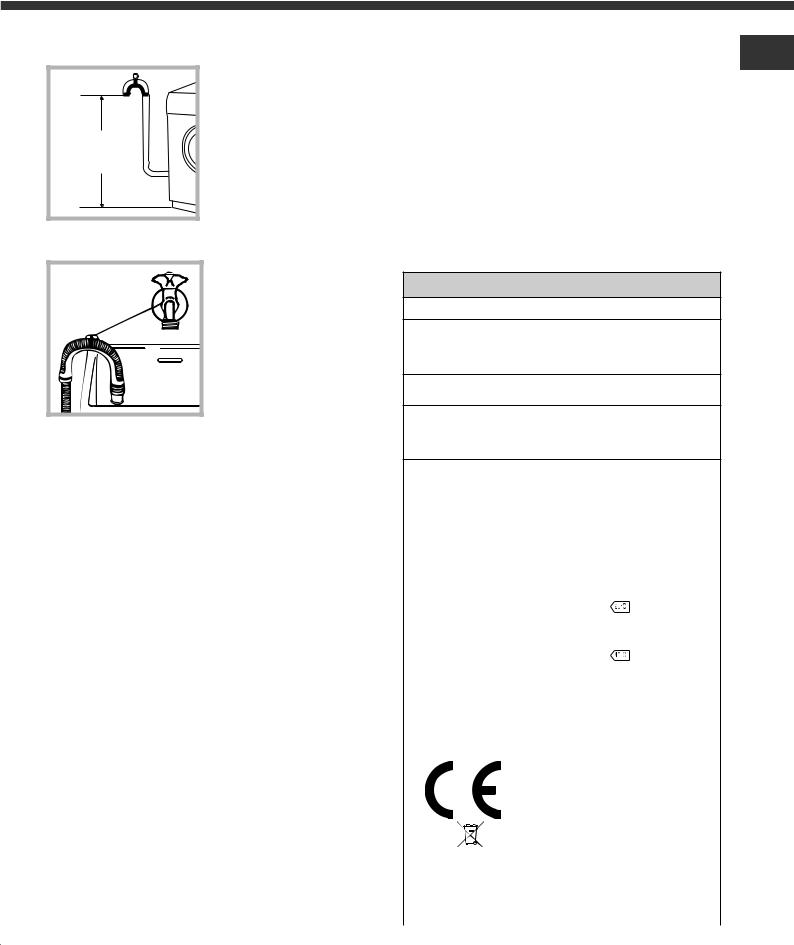
Σύνδεση του σωλήνα αποστράγγισης |
! Το καλώδιο δεν πρέπει να φέρει πτυχές ή |
GR |
||
|
Συνδέστε το σωλήνα |
να είναι συμπιεσμένο. |
|
|
|
! Το καλώδιο τροφοδοσίας και το βύσμα |
|
||
|
αδειάσματος σε |
πρέπει να αντικαθίστανται μόνο από |
|
|
|
μια σωλήνωση |
εξουσιοδοτημένους τεχνικούς. |
|
|
|
αδειάσματος ή |
Προσοχή! Η επιχείρηση αποποιείται κάθε |
|
|
65 - 100 cm |
σε μια επιτοίχια |
ευθύνης σε περίπτωση που δεν τηρούνται |
|
|
|
παροχέτευση σε |
αυτοί οι κανόνες. |
|
|
|
ύψος από το έδαφος |
|
|
|
|
μεταξύ 65 και 100 cm |
|
|
|
|
και αποφεύγοντας |
|
|
|
|
ρητά να τον |
|
|
|
|
διπλώσετε. |
|
|
|
|
Εναλλακτικά, |
|
|
|
|
στηρίξτε το σωλήνα |
ФечнйкЬ уфпйчеЯб |
|
|
|
αδειάσματος στο |
МпнфЭлп |
AQ113DA 697 |
|
|
χείλος ενός νιπτήρα |
|
||
|
ή μιας λεκάνης, |
|
рлЬфпт cm 59,5 |
|
|
δένοντας τον οδηγό |
ДйбуфЬуейт |
ýøïò cm 85 |
|
|
που σας παρέχεται |
|
вЬипт cm 64,5 |
|
|
στον κρουνό (βλέπε |
Чщсзфйкьфзфб áðü 1 Ýùò 11 kg |
|
|
|
εικόνα). Το ελεύθερο |
|
||
|
άκρο του σωλήνα |
|
ВлЭре фзн рйнбкЯдб |
|
|
αδειάσματος δεν |
ЗлекфсйкЭт |
|
|
|
чбсбкфзсйуфйкюн ерЯ фзт |
|
||
πρέπει να παραμένει βυθισμένο στο νερό. |
ухндЭуейт |
|
||
мзчбнЮт |
|
|||
|
|
|
|
|
! Δεν συνιστάται η χρήση προεκτάσεων |
|
|
|
мЭгйуфз рЯеуз |
|
|
||
σωλήνων. Αν απαιτείται, η προέκταση πρέπει |
УхндЭуейт |
1 MPa (10 bar) |
||||||
να έχει την ίδια διάμετρο του αρχικού σωλήνα |
ЕлЬчйуфз рЯеуз |
|
|
|||||
неспэ |
|
|
||||||
και να μην ξεπερνάει τα 150 cm. |
0,05 MPa (0,5 bar) |
|||||||
|
|
|
||||||
Ηλεκτρική σύνδεση |
|
|
|
чщсзфйкьфзфбфпхкЬдпх71лЯфсб |
||||
Фбчэфзфб |
мЭчсй 1600 уфспцЭт фп |
|
||||||
Πριν εισάγετε το βύσμα στην ηλεκτρική πρίζα, |
уфхшЯмбфпт |
лерфь |
|
|
||||
Προγράμματα |
|
|
|
|||||
βεβαιωθείτε ότι: |
рсьгсбммб |
; |
|
|||||
• |
η πρίζα διαθέτει γείωση και τηρεί τις εκ του |
ελέγχου |
ΒΑΜΒΑΚΕΡΑ ΚΑΝΟΝΙΚΌ |
|||||
|
νόμου προδιαγραφές. |
σύμφωνα με |
60°C. |
|
|
|||
• |
Η πρίζα να είναι σε θέση να υποφέρει |
τις οδηγίες |
рсьгсбммб |
; |
|
|||
|
το μέγιστο φορτίο ισχύος της μηχανής, |
1061/2010 |
ΒΑΜΒΑΚΕΡΑ ΚΑΝΟΝΙΚΌ |
|||||
|
που αναφέρεται στον πίνακα Τεχνικών |
και |
40°C. |
|
|
|||
|
στοιχείων (βλέπε δίπλα). |
1015/2010 |
|
|
|
|||
• |
Η τάση τροφοδοσίας να κυμαίνεται μεταξύ |
|
|
|
З ухукехЮ бхфЮ |
|
||
|
των τιμών που αναφέρονται στον πίνακα |
|
|
|
|
|||
• |
Τεχνικών στοιχείων (βλέπε δίπλα). |
|
|
|
еЯнбй уэмцщнз ме фйт |
|||
Η πρίζα να είναι συμβατή με το βύσμα |
|
|
|
бкьлпхиет КпйнпфйкЭт |
||||
|
της μηχανής. Σε αντίθετη περίπτωση, |
|
|
|
ПдзгЯет: |
|
|
|
|
αντικαταστήστε την πρίζα ή το βύσμα. |
|
|
|
- 2004/108/CE |
|||
! |
Το πλυντήριο δεν εγκαθίσταται σε |
|
|
|
(ЗлекфспмбгнзфйкЮ |
|
||
ανοιχτό χώρο, ακόμη και αν ο χώρος είναι |
|
|
|
Ухмвбфьфзфб) |
|
|
||
καλυμμένος, διότι είναι πολύ επικίνδυνο να το |
|
|
|
- 2012/19/EU |
||||
αφήνετε εκτεθειμένο σε βροχή και κακοκαιρία. |
|
|
|
-2006/95/CE(ЧбмзлЮФЬуз) |
||||
|
|
|
||||||
|
|
|
||||||
! |
Με την εγκατάσταση του πλυντηρίου, η πρίζα |
|
|
|
|
|
|
|
θόρυβος |
|
|
|
|||||
ρεύματος πρέπει να είναι εύκολα προσβάσιμη. |
Πλύσιμο: 53 |
|
|
|||||
(dB(A) re |
|
|
||||||
! Μη χρησιμοποιείτε προεκτάσεις και |
Στύψιμο: 82 |
|
|
|||||
1 pW) |
|
|
||||||
πολύπριζα. |
|
|
|
|||||
|
|
|
|
|
|
|||
|
|
|
|
|
|
|
|
|
15
